|


This Page
is being updated
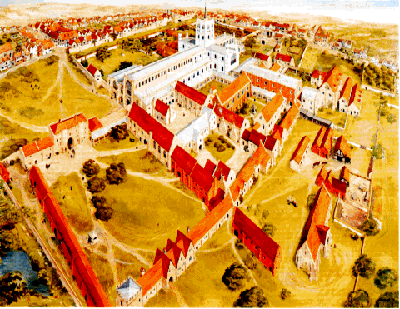
St. Albans Abbey as it may have appeared
in 1539
(from a painting by Joan Freeman)
|
|
|
|
At some time in the third century Alban was
martyred for his christian faith and buried on a
hill top over looking the city of Verulamium.
Eventually a shrine or church was built over his
grave and the historian Bede, writing c.730
implies that this was done in Roman times and
states that miracles still took place there. The
Gallic Bishop, St. Germanus of Auxerre visited the
shrine in 429. The Abbeys own historians recorded
that the Abbey was founded by the great King Offa
of Mercia in 793, after the saints resting place
had been revealed to him in a dream. However it is
unlikely that this had been forgotten by the two
generations since Bede's time and it seems likely
that Offa reorganised an existing religious
community and probably imposed the rule of St.
Benedict. He also endowed the house with extensive
lands.
Little is known about the Anglo-Saxon Abbey but
it seems to have had two churches and was a mixed
house with both monks and nuns.
|
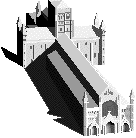
The Abbey Church today after
Victorian "restoration"
|
|
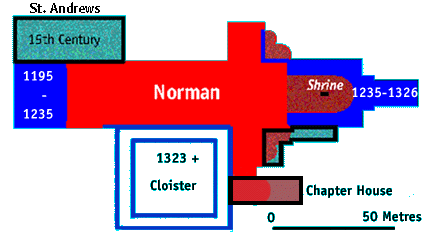
|
|
Schematic Plan showing the Medieval
development of the Abbey Church
|
Eleven years after the Norman Conquest, in 1077, Paul of
Caen was appointed Abbot and set about rebuilding not only
the Church but also the conventual buildings. The great
church was finally completed and dedicated in the presence
of king Henry I in 1115. Most of the building materials were
quarried from the ruins of Roman Verulamium.
TheChapter
House was rebuilt by Abbot Robert de Gorham (1151-66)
around the time when the local Hertfordshire man, Nicholas
Breakspear, became Pope Adrian IV (1154-9), the only English
Pope. It was Pope Adrian who made the Abbey the premier
abbey of England.
In the period 1195-1235 the church was extended to the
west and the west front provided with porches. During this
period, in 1213 a council was held at the Abbbey at which
Magna Carta was drafted.
Later in the 13th century work took place at the other
end of the church when the presbytery was extended eastwards
(1235-c.1290). A further eastward extension took
place early the next century (1308-1326) when the Lady
Chapel was built. The existing shrine of St. Alban, now
happily restored to something like its former glory, was
built c.1302-1308.
In 1323-1327 five bays of the south nave, along with the
cloister, were
rebuilt after part of the nave wall collapsed.
|
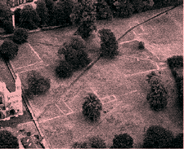
Aerial photo showing the
foundations of the demolished
Abbey buildings revealed as "parch marks"
in the grass of the Abbey Orchard.
The cloisters are visible top left.
(photo - St. Albans Museums)
|
The
Abbey Buildings
|
Of the buildings which housed and protected the
monastery few survived the dissolution of 5th
December 1539 and the demolition which followed.
The buildings surrounding the
Great Court were
reserved by the crown and survived for nearly two
centuries. These consisted of the great stables on
the west, guest houses on the east and the
Water Gate on the
south.
This is the only building to survive. It was
built c.1365 after its predecessor had been
destroyed in the great storm of 1362. Originally
the roof was of lower pitch than that of today and
covered in lead.The gate served in part as the
Abbots prison and in 1381 the gate keeper opened it
to the insurgents who released the four prisoners
then in custody, one of whom must have upset them
for him they beheaded and set his head on the
pillory in the market place.
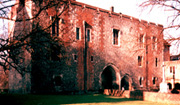
The 14th Century Great
Gate
|
|
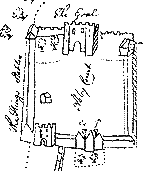
The Great Court as
mapped in 1634
|
|
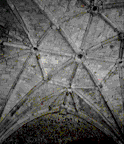
The Vaulting of the
Great Gate
|
In 1357 the Abbey received a licence to
crenellate, from the crown. In effect to
become a castle and was surrounded by a strong
precinct wall. A scar on the east wall of the great
gate shows the height of this wall here, as shown
on a map of 1634.
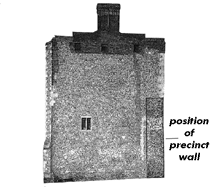
|
Holywell
Gate
was situated near the bridge towards the
south-east corner of the precinct. Its exact site is not
known and excavations, at a location proposed in the 19th
century, revealed no trace of a gate.
|
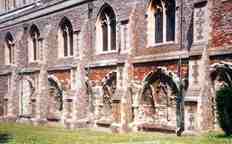
|

|
|
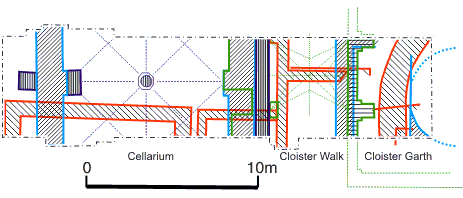
The Sequence of
Buildings revealed by Excavation in
1982-3
(after
Biddle & Kjølbye-Biddle)

|
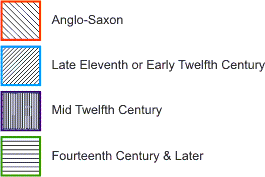
|
|
The
Chapter House
|
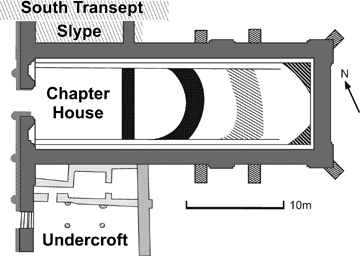
The Foundations of the Chapter House
excavated in 1978-79
(after Biddle &
Kjølbye-Biddle) 
|
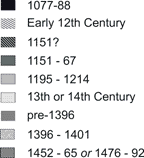
|
|
|
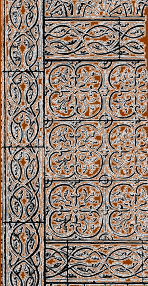
Part of the relief tile floor
of Robert de Gorham's Chapter House
|


|